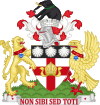History of Site
The Memorial Hall and Caroone House were built on the site of the old Fleet Prison. The prison was burnt down during the Great Fire of London and while the prison was being rebuilt, the prisoners were relocated to Caron House, South Lambeth, a large mansion house which had been built by Noel de Caron the Netherlands ambassador to England in the reigns of Elizabeth I and James I. [2] In 1685 Caron House was demolished but the name survived and in the 19th century there was a "Carroun House" on the estate – which has been known as Vauxhall Park since 1890. [3] As a consequence of this rich history, "Caroone House" was adopted as an appropriate name for the new building in Farringdon Street.
A Greater London Council plaque commemorating the foundation of the Labour Party at the Memorial Hall in 1900 was displayed at the main entrance to Caroone House.
This page is based on this
Wikipedia article Text is available under the
CC BY-SA 4.0 license; additional terms may apply.
Images, videos and audio are available under their respective licenses.




